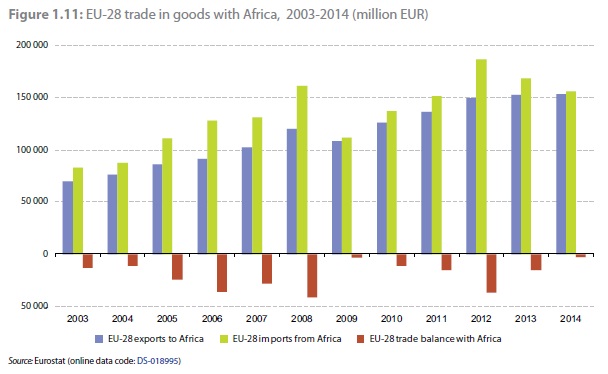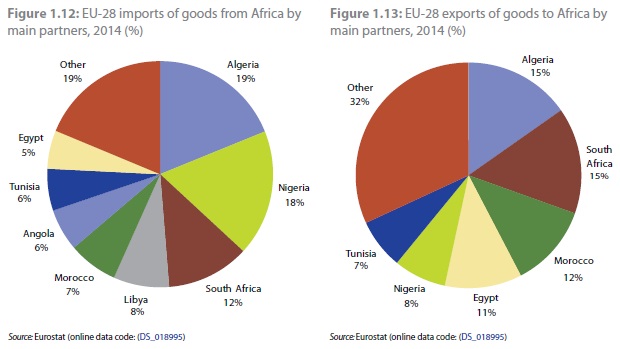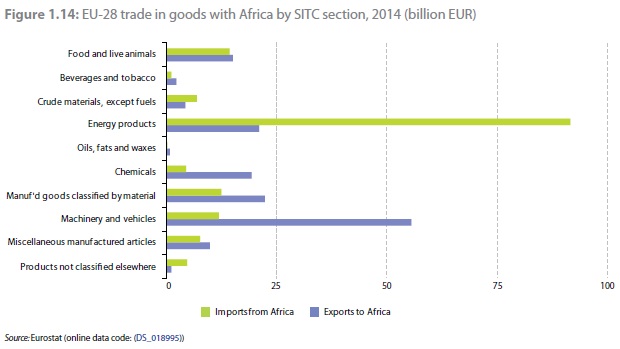News
The European Union and the African Union: A statistical portrait

This “statistical portrait” 2015 edition presents a broad comparison between the situation of the European Union, including EFTA members and Candidate countries, and the African Union, its member states and non-member states. The publication is jointly produced by Eurostat and the Statistics Division of the African Union Commission (AUSTAT) on the basis of data from both organisations.
With data up to and including the year 2014, this “portrait” includes various domains such as demography, health, education, national accounts, trade, and more. Tables in the eight chapters help the user to gain a detailed view on different aspects, such as mobile phone subscriptions, number of teachers, life expectancy, GDP, tourism, etc. An overview chapter is also included, presenting statistical comparisons with the rest of the world.
Africa-EU Strategic Partnership
Africa’s continental integration is a key priority for the strategic partnership between the African Union and the EU. The new Pan-African Programme will provide a major contribution to the EU-Africa Partnership, established by the two continents in 2007 with the Joint Africa-EU Strategy (JAES), in order to put their relations on a new footing. The programme is a key instrument for the European Union to implement, in close cooperation with African partners, the political priorities of the Joint roadmap 2014-17, which was adopted by African and EU Heads of State and Government during the 4th EU-Africa summit in April 2014.
During the seventh College to College (C2C) meeting between the European Commission and the African Union Commission, which took place on 22nd April 2015 in Brussels, political and operational impetus to the Joint Africa-EU Strategy was confirmed in view of the five priority areas of the Joint Roadmap:
-
Peace and Security
-
Democracy, Good Governance and Human Rights
-
Human development
-
Sustainable and inclusive development and growth and continental integration
-
Global and emerging issues
The Colleges considered these topics during a plenary session, co-chaired by the President of the European Commission, Jean-Claude Juncker, and the Chairperson of the African Union Commission, Nkosazana Dlamini-Zuma. For each of these objectives, a number of actions have been identified at interregional, continental or global levels which are expected to have a real impact on the people of both continents.
To achieve the strategic objectives of priority 4 (such as economic growth for poverty reduction, creation of decent jobs; development of the private sector; continental integration, energy, industrialisation and investment) particular support for statistical capacity building has been considered essential by the partners: “Decisions to invest or develop new policies need to be based on reliable and comparable data. We will enhance cooperation between European and African Statistical Systems in producing quality statistical service.”
The Pan-African Statistics (PAS) programme, as part of the overall Pan-African Programme, therefore aims to support African integration by improving the availability and quality of statistical information required for informed decisionmaking and policy monitoring.
To this end it will provide technical assistance to enhance harmonisation and coordination of statistics on the continent and to foster institutional capacity building. In this context it will also support preparations in view of a statistical institute at AU level, the creation of which was decided by the African Heads of States and Governments in January 2013.
International trade
Africa accounted for around 9% of both the imports to the EU-28 and the exports from the EU-28 in 2014, measured by value. This was far below Asia, which stood for 43% of the imports value to the EU-28 and about a third of the exports value. Northern America only accounted for 14% of the imports to the EU-28 but was the destination for 21% of the exports.
The EU-28 goods trade balance with Africa was negative in all years between 2003 and 2014 (Figure 1.11). The EU’s trade deficit with Africa fell sharply from EUR 41 billion in 2008 to around EUR 4 billion in 2009 with both import and export values dropping, clearly reflecting the worldwide economic crisis. This decline in EU-28 exports to and imports from Africa broke the steady increase of EU-28 trade with Africa between 2003 and 2008, which had seen export values raise by 71% and imports by 94%. From 2009 onwards, EU-28 exports to Africa returned to steady growth; by 2014, the value of EU-28 exports to Africa was 28% above the 2008 level. Also the imports from Africa resumed the strong growth in 2009, exceeding the pre-crisis value by 16% in 2012. However, in 2013 and 2014 the value of EU-28 imports from Africa again decreased; it fell by 11% in 2013 and by another 8% from 2013 to 2014, reaching a lower value in 2014 than prior to the economic crisis.

In 2014, the three main African partners for imports of goods to the EU-28 were Algeria (19% of total import value from Africa), Nigeria (18%) and South Africa (12%) (Figure 1.12). Together, these three countries accounted for close to half the total EU-28 imports from Africa. For both Algeria and Nigeria, the main product group imported to the EU-28 was petroleum products, more specifically crude oil and natural gas. Thus, due to the fall in petroleum prices, the value of this trade can change substantially from year to year. Libya, recorded third in 2013, lost 6 percentage points from 2013 to 2014 due to this effect and to the effects of the continued instability following the Civil War of 2011. The result was that Libya ranked fourth for imports to the EU-28 in 2014, with 8% of the total. The main African destinations for EU- 28 exports of goods were Algeria and South Africa (each 15% of total exports to Africa in 2014), followed by Morocco (12%) (Figure 1.13).

In 2014, EU-28 exports to Africa were dominated by machinery and vehicles, in particular road vehicles; with EUR 55.5 billion, this product group accounted for more than a third of the total value. For EU-28 exports of energy products to Africa, there was a significant reverse flow of refined oil products, amounting to some EUR 21.0 billion in 2014. Another important export product group from the EU-28 to Africa was manufactured products classified by material, which reached 22.4 billion EUR in 2014 (Figure 1.14). This represented 15% of the total EU-28 exports to Africa. A further important group of products exported to Africa was chemicals, with a share of 13% of the total in 2014.

From 2013 to 2014, the value of exports to Africa of machinery and vehicles, the most important product group by far, remained stable. Amongst the other main product groups, the export value from EU-28 to Africa fell by more than 7% for energy products and almost 1% for manufactured products classified by material. In contrast, the EU-28 exports of food and live animals to Africa continued to rise by a further 9% from 2013 to 2014. The value of chemicals exports increased by almost 3%.
On the import side, the value of energy products imports from Africa decreased by 12% from 2012 to 2013, followed by a drop of another 15% in 2014. This downturn was partly due to a strong fall in imports of energy products from Libya, which could not recover from a sharp decline caused by the civil uprising in 2011 and the renewed unrest from 2013 onwards. With the exception of energy products, of oils, fats and waxes and of manufactured goods classified by material, all main product groups recorded growth in EU-28 imports from Africa between 2013 and 2014.




